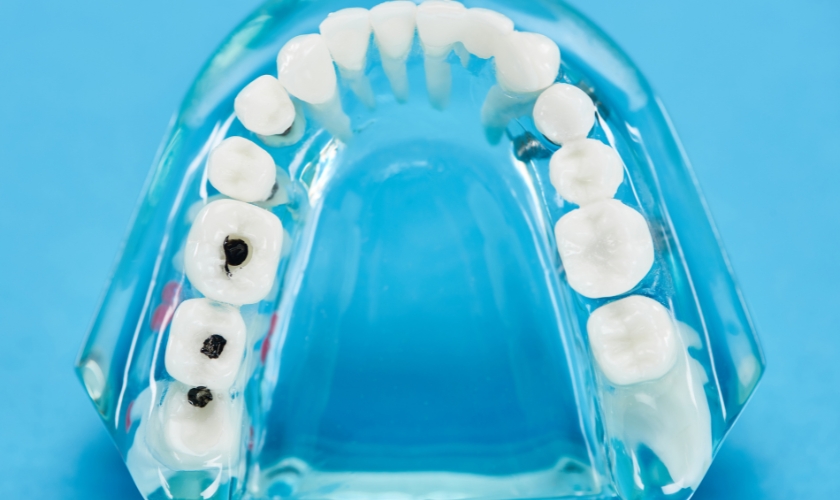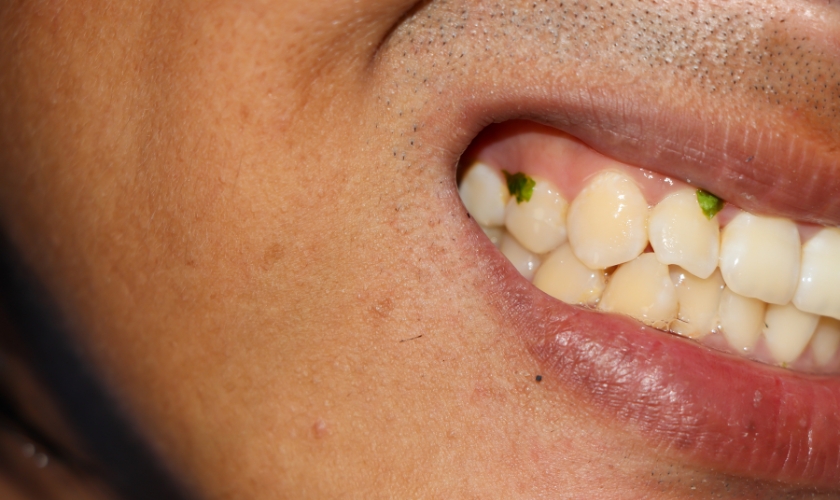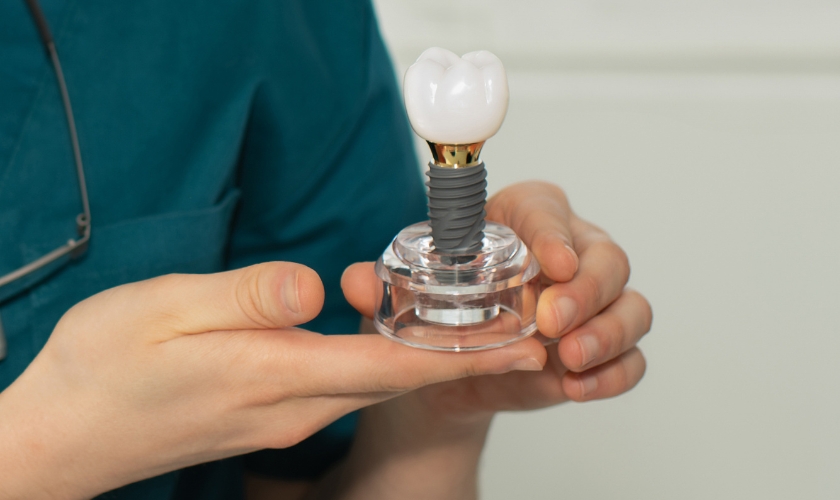
By Gentle Touch Dentistry Richardson
What Are Full-Arch Dental Implants?
Considering replacing all your missing teeth in an arch with a permanent, natural-looking solution? Full-arch dental implants in Richardson, TX, might be the answer you’ve been looking for. This innovative procedure utilizes strategically placed implants to support a full arch of prosthetic teeth, restoring your smile, function, and confidence.
A. Definition and Purpose
Full-arch dental implants are a type of implant-supported restoration designed to replace all the teeth in your upper or lower jaw or even both arches. These implants are small, screw-like posts typically made of biocompatible titanium. They are surgically inserted into your jawbone, where they fuse with the bone through a process called osseointegration. This creates a stable foundation for a full arch of custom-made prosthetic teeth.
B. Benefits of Full-Arch Implants
Unlike traditional dentures that can slip and cause discomfort, full-arch implants offer a multitude of advantages:
- Enhanced Chewing Ability: Implants function like natural tooth roots, providing exceptional stability and bite force. This allows you to enjoy a wider variety of foods without worry.
- Improved Speech: Traditional dentures can sometimes affect speech clarity. Full-arch implants eliminate this issue, letting you speak confidently and clearly.
- Preserved Facial Structure: Tooth loss can lead to bone resorption in the jaw, which can cause facial sagging. Implants stimulate the jawbone and prevent this deterioration, maintaining a youthful appearance.
- Increased Confidence: A beautiful, functional smile can significantly boost your confidence and self-esteem. Full-arch implants allow you to smile, laugh, and eat freely without self-consciousness.
C. Advantages of Traditional Dentures & Bridges
While traditional dentures and bridges can be effective tooth replacement options, full-arch implants offer several key advantages:
- Superior Stability: Implants are anchored directly into the jawbone, providing unparalleled stability compared to dentures that rest on the gums. This eliminates slipping, clicking, and the need for denture adhesives.
- Improved Comfort: Traditional dentures can irritate the gums and cause discomfort. Implants feel and function more like natural teeth, offering superior comfort throughout the day.
- Durability: Full-arch implants are designed to last a lifetime with proper care, while dentures may need to be replaced more frequently.
- Preserves Jawbone Health: Implants stimulate the jawbone and prevent bone resorption, a common issue with tooth loss.
D. Ideal Candidates for Full-Arch Implants
Full-arch implants are a great option for patients who have lost all or most of their teeth in an arch due to various reasons like decay, gum disease, or injury. They are also suitable for individuals with:
- Adequate jawbone density to support the implants
- Good overall health
- Non-smoking habits (smoking can impede healing)
- Realistic expectations about the procedure
Types of Full-Arch Dental Implants
There are several types of full-arch dental implants available, each with its own advantages and considerations. Here’s a breakdown of the most common options:
A. Implant-Supported Dentures
These dentures are similar to traditional dentures but are secured by strategically placed implants. They can be:
- Fixed: Permanently attached to the implants using screws or a bar, offering exceptional stability and eliminating the need for removal.
- Removable: It can be snapped onto the implants for easy cleaning and maintenance but may require removal at night.
B. All-on-4 Implants
This technique utilizes only four implants strategically placed in the jawbone to support a full arch of prosthetic teeth. It’s a popular option for patients with bone loss who may not be ideal candidates for traditional implant placement.
C. Zygomatic Implants
These specialized implants are used in cases of severe bone loss in the upper jaw, where traditional implants cannot be placed due to insufficient bone volume. Zygomatic implants are anchored in the cheekbone (zygoma) for a more stable foundation.
D. Factors to Consider When Choosing an Implant Type
The best type of full-arch implant for you will depend on several factors, including:
- Bone health and density: Your dentist near Richardson will assess your jawbone to determine if it can support traditional implants or if alternative options like zygomatic implants are necessary.
- Number of missing teeth: If you have all your teeth missing in an arch, all the options above may be suitable. If you have some remaining teeth, they may need to be extracted before implant placement.
- Desired level of permanency: Consider whether you prefer a fixed or removable implant-supported denture.
- Cost: Different implant types can vary in cost. Discuss your budget with your dentist near you.
Choosing the right implant type is crucial for a successful outcome. Your Richardson dentist will carefully evaluate your individual needs and recommend the most suitable option for you.
The Full-Arch Implant Procedure
The full-arch implant procedure typically involves several stages spread out over several months. Here’s a breakdown of what you can expect:
A. Consultation and Treatment Planning
The first step is a comprehensive consultation with a dentist in Richardson, TX, specializing in dental implants. During this consultation, your dentist will:
- Review your medical and dental history
- Conduct a thorough oral examination, including X-rays and 3D scans, to assess your jawbone health and anatomy
- Discuss your goals and expectations for the procedure
- Develop a personalized treatment plan, including the type of implants, number of implants needed, and surgical approach
B. Surgical Process (step-by-step explanation)
Once the treatment plan is finalized, the surgical procedure can take place. Here’s a general outline of the steps involved:
- Anesthesia: You will be administered general anesthesia or local anesthesia with sedation, depending on your preference and the complexity of the surgery.
- Tooth Extraction (if necessary): Any remaining teeth in the treatment area may need to be extracted before implant placement.
- Implant Placement: The surgeon will make precise incisions in the gum tissue and create small openings in the jawbone. The implants will then be carefully inserted into the prepared sites.
- Abutment Placement (optional): In some cases, abutments, which are small connectors, may be placed on the implants during this surgery. Otherwise, they might be placed in a separate procedure after healing.
- Temporary Prosthesis (optional): Depending on the treatment plan, temporary teeth or a denture may be attached to the implants or abutments for immediate aesthetics and function.
- Stitching and Bandaging: The surgical site will be stitched closed, and bandages may be applied for swelling control.
C. Anesthesia Options (general, local)
The type of anesthesia used will depend on your Richardson dentist’s recommendation and your comfort level. Here’s a brief overview of the options:
- General anesthesia: Puts you into a complete state of sleep during the surgery.
- Local anesthesia with sedation: Numb the surgical area while you remain awake and relaxed.
D. Pain Management During and After Surgery
Your dentist near Richardson will prescribe medication to manage any discomfort you may experience after surgery. Following their instructions and using ice packs can also help reduce swelling and pain.
Recovery and Aftercare After Full-Arch Implants
Following your full-arch implant surgery, proper recovery and aftercare are essential for optimal healing and long-term success. Here’s what you can expect:
A. Timeline for Healing and Osseointegration
Healing after full-arch implant placement typically occurs in stages:
- Initial Healing (1-2 weeks): You may experience some swelling, discomfort, and slight bleeding. Following your dentist’s instructions in Richardson, TX for pain medication and applying ice packs can help manage these symptoms.
- Osseointegration (3-6 months): During this critical period, the implants fuse with the jawbone through a process called osseointegration. A soft diet is recommended during this time to minimize stress on the implants.
- Abutment Placement and Prosthetic Delivery (optional): In some cases, abutment placement might be a separate procedure after osseointegration is complete. Once the abutments are healed, your dentist will take impressions for your final prosthetic teeth.
- Placement of Final Prosthetic Teeth: Your custom-made full arch of teeth will be securely attached to the implants, completing the restoration process.
B. Potential Temporary Side Effects
It’s normal to experience some temporary side effects after surgery, such as:
- Swelling
- Bruising
- Discomfort
- Minor bleeding
These side effects should gradually subside within a few days. If you experience any severe or prolonged discomfort, contact your dentist near Richardson immediately.
C. Diet Modifications During Recovery
Following a soft diet for the first few months after surgery is crucial to allow the implants to heal properly. Soft foods put minimal stress on the implant sites and promote healing. Your dentist in Richardson, TX will provide specific dietary recommendations based on your individual case.
D. Proper Oral Hygiene Practices for Implants
Maintaining excellent oral hygiene is vital for the long-term success of your implants. This includes:
- Brushing your teeth twice a day with a soft-bristled brush and fluoride toothpaste.
- Flossing daily to remove plaque and food particles from between the teeth and around the implants.
- Using a special implant cleaning tool recommended by your dentist.
- Attend regular dental checkups and cleanings to monitor your implants and oral health professionally.
By following these aftercare practices, you can ensure optimal healing and maximize the lifespan of your full-arch dental implants in Richardson.
Frequently Asked Questions
How Long Do Full-Arch Implants Last?
With proper care and maintenance, full-arch implants can last a lifetime. The implants themselves are very durable and can integrate seamlessly with your jawbone. The prosthetic teeth may need to be replaced every 10-15 years due to normal wear and tear.
Are Full-Arch Implants Safe?
Full-arch implants are a safe and well-established procedure with high success rates. However, like any surgery, there are some potential risks involved, such as:
- Infection
- Bleeding
- Nerve damage
- Sinus problems (in upper jaw implants)
Will I be able to eat normally right away after surgery?
No, following a soft diet for the first few months after surgery is crucial for optimal healing. Your dentist will provide specific recommendations on dietary modifications during this time.
What happens if an implant fails?
Implant failure is rare, but it can happen. If an implant fails to integrate with the jawbone, it may need to be removed and replaced. Regular dental checkups allow your dentist to monitor your implants and address any potential issues early on.






